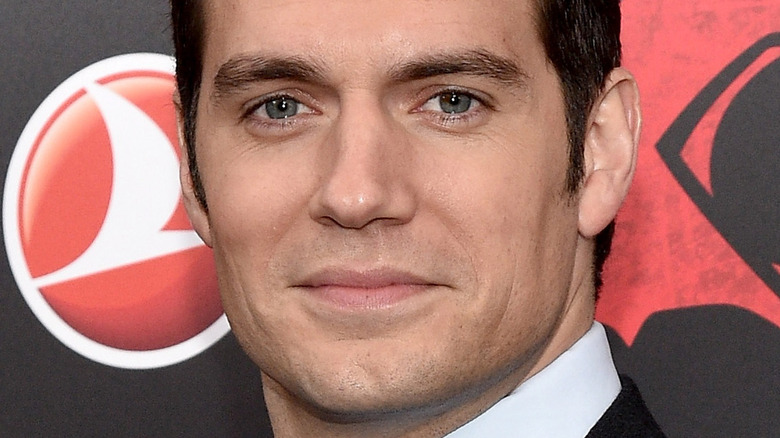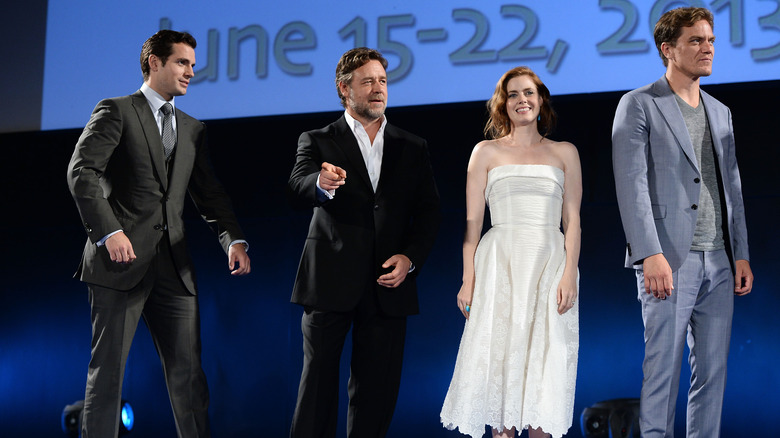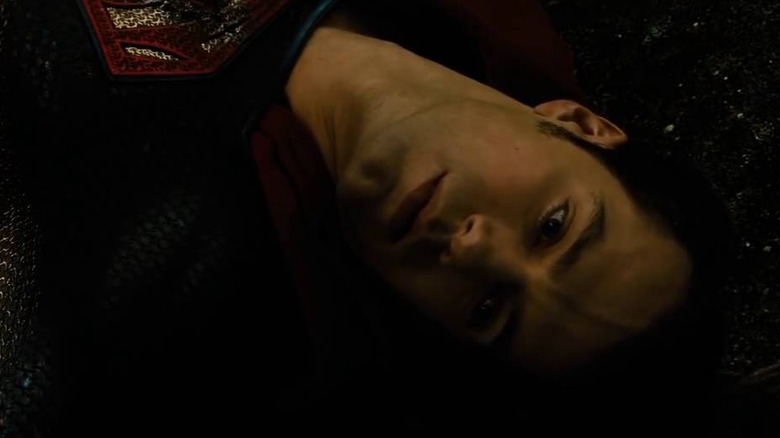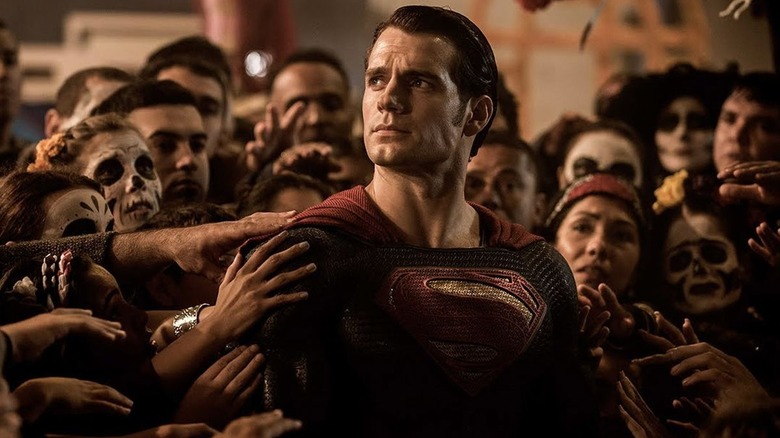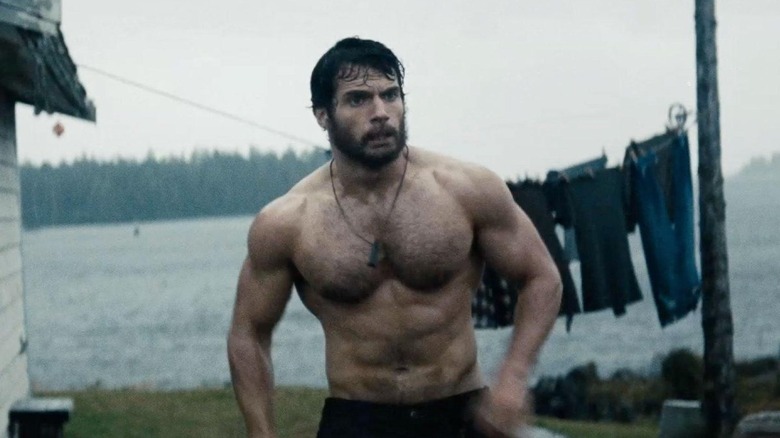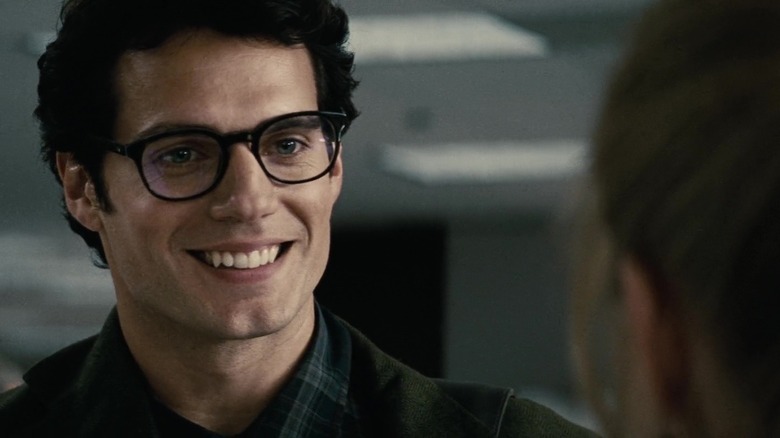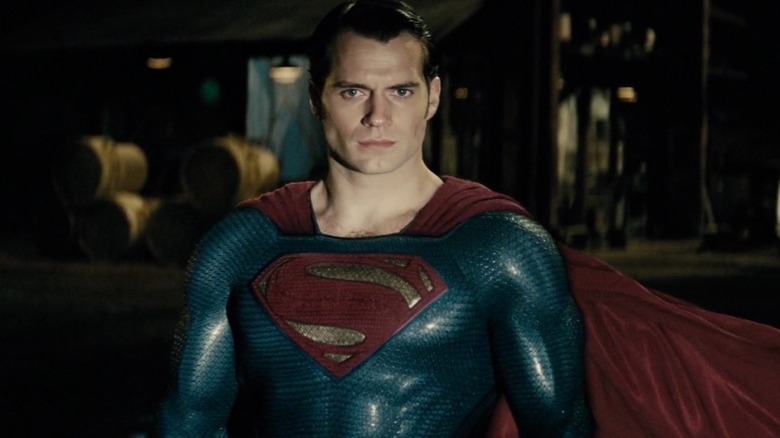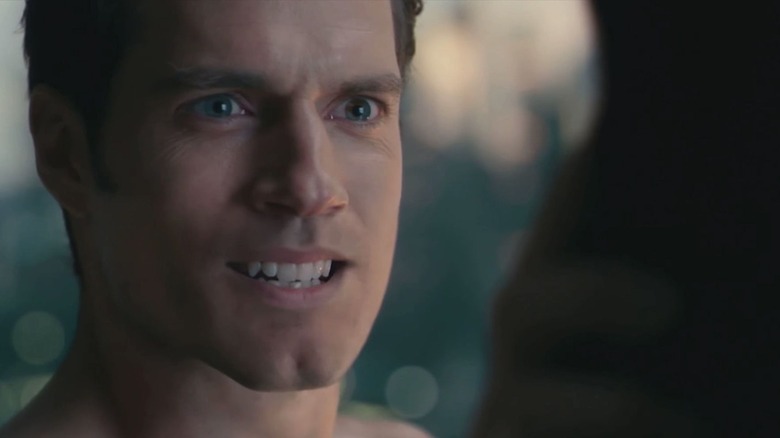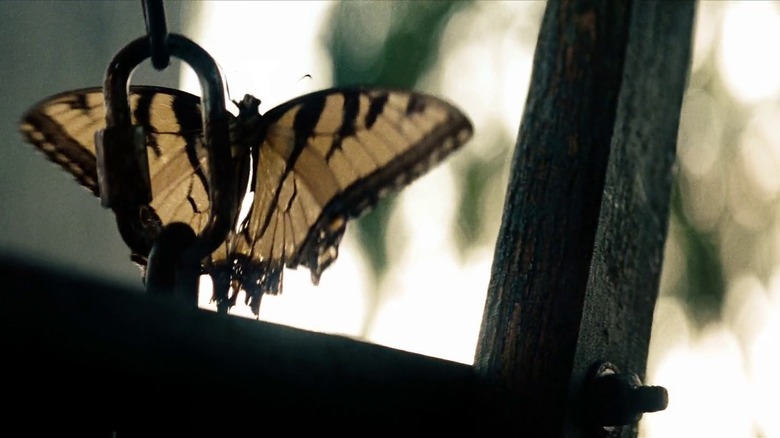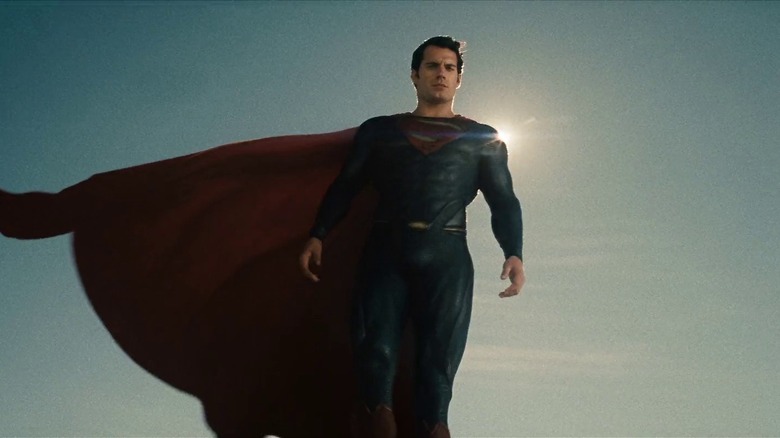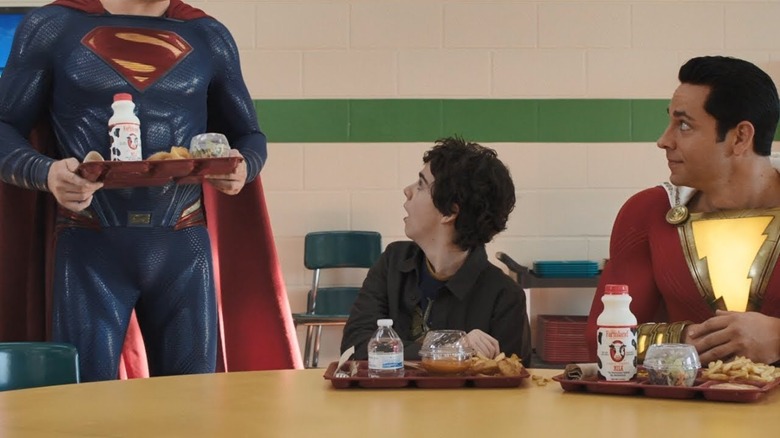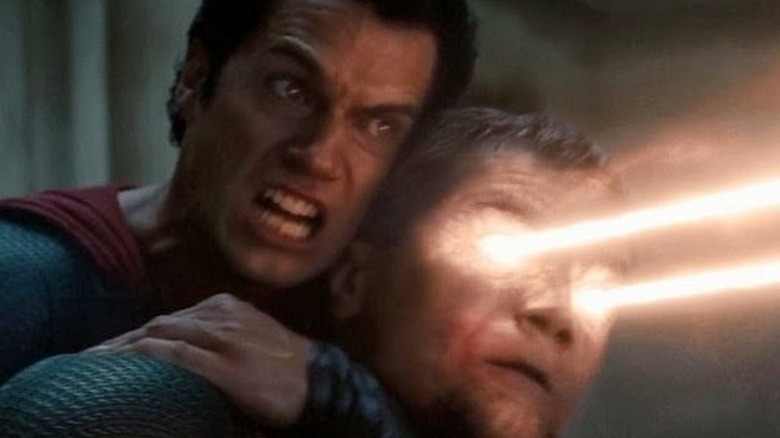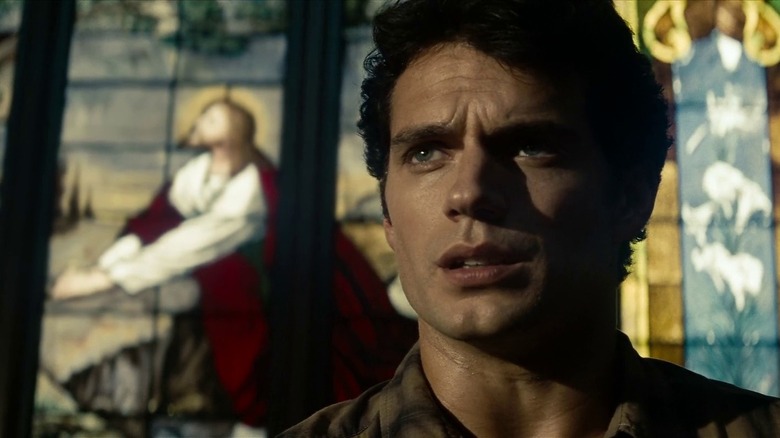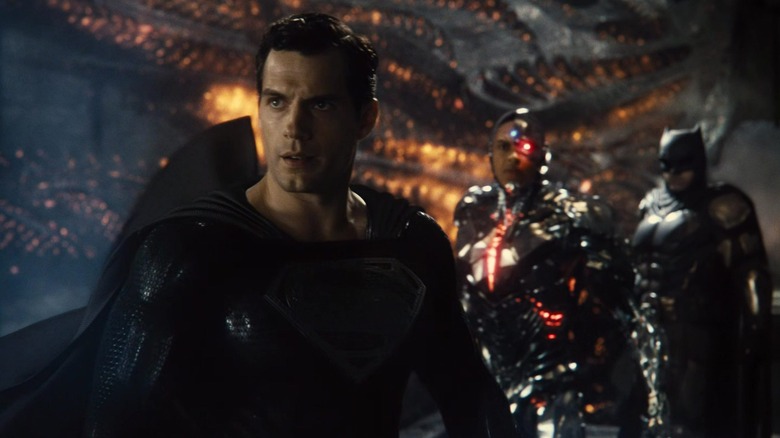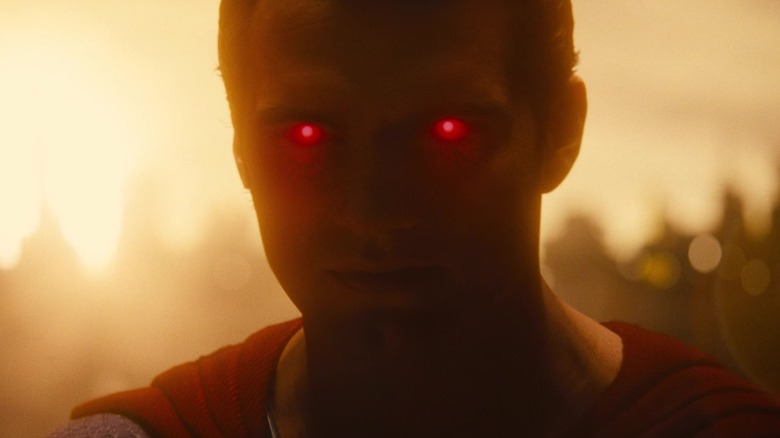The Untold Truth Of Henry Cavill's Superman
The DC Extended Universe (DCEU) was launched with much fanfare in 2013 with "Man of Steel." The movie tells the origin story of DC Comics' flagship character, Superman. Kal-El of the planet Krypton gets rocketed to Earth as an infant, where he's adopted by a human couple who raise him as Clark Kent, played in the movie by Henry Cavill. Growing up in Earth's atmosphere, Clark discovers he has a host of amazing abilities and chooses to use them for the benefit of mankind as the hero dubbed "Superman."
Over the next few years, Cavill's Superman showed up in a host of DCEU movies as the franchise tried to create a shared cinematic franchise that could rival the might of the Marvel Cinematic Universe. But ever since his 2013 debut, this new version of Superman has divided fans and critics. Some consider him too dark and brooding, while others believe him to be more grounded and realistic. Whether or not you're on board with Cavill's take on Superman, it's clear that a lot of thought and effort has gone into crafting the character. Let's take a look at some of the lesser-known details about the inception and journey of the DCEU's Man of Steel.
Distant connections
Working on a "Superman" movie would be a dream project for many actors. But when it comes to "Man of Steel," it's remarkable how many of the main cast members had connections to the project and each other going back decades.
For instance, Henry Cavill had initially auditioned to play the character in "Superman Returns" all the way back in 2006 but was passed over for Brandon Routh. Meanwhile, Amy Adams had been a fan of Superman for years. She'd already unsuccessfully auditioned to play Lois Lane twice – in the unproduced "Superman: Flyby" and "Superman Returns" — before finally landing the part in "Man of Steel." Adams also had another connection to the franchise through a supporting role she played on the TV show "Smallville" as a student at Clark Kent's high school.
Finally, Russell Crowe plays the role of Superman's father Jor-El in "Man of Steel." In 2000, Crowe met Henry Cavill when the latter was a background character on Crowe's movie "Proof of Life." At the time, Crowe took notice of Cavill, who asked for Crowe's advice about pursuing an acting career. Before parting ways at the end of the project, Crowe gave Cavill a few gifts, with the young actor telling CNN, "I received an Aussie rugby jersey, some Aussie sweets, some Vegemite, a band CD, and a picture of him in 'Gladiator' saying, 'Dear Henry, a journey of a thousand miles begins with a single step. Russell.'"
An aborted character arc
One of the biggest criticisms about "Man of Steel" is that the film made Superman into an unnecessarily dark and brooding character instead of the cheerful and confident symbol of hope that most audiences remembered from Christopher Reeve's era of "Superman" movies. However, the idea that Cavill's Superman needs to be more upbeat and "smile more" is one that the actor and the makers of "Man of Steel" were always on board with. It's just that they wanted to take a longer road towards Superman becoming the classic symbol of hope for humanity. Cavill has often spoken of his desire to make Superman closer to the Reeves' version but only after taking him on a journey of self-discovery and soul-searching.
"I was very keen on really fleshing out Superman's early stages of his journey first," Cavill told GQ about his character's darker journey through "Man of Steel" and "Batman v Superman." However, in films that have yet to be made, Cavill hoped to take the hero in a different direction, saying, "If he were to succumb to [Darkseid's] Anti-Life Equation and become Bad Superman, I really wanted to make sure that we saw the hero Superman and we saw the true symbol of hope, the beacon of light before he went down the path of darkness and then redemption. And it's still something I'm very keen to flesh out."
Changing to become Superman
Playing Superman comes with a burden of expectations like no other superhero. While guys like Batman and Spider-Man are allowed to be human and fallible, Superman must always project a larger-than-life air of perfection while somehow also being relatable. Naturally, Henry Cavill had to really prepare himself physically and mentally to take on such an iconic role.
In order to build a physique worthy of Superman, Cavill took the help of noted Hollywood trainer Mark Twight. In an interview with the New York Daily News' Confidential, Twight revealed how Cavill had to eat so much food he fell sick. Twight also had the actor, who was 30 at the time, undergo a daily "90-minute military style workout for a year" to get into fighting shape.
Aside from the physical strain, Cavill also had to find a way to portray Superman in a new manner. He consciously avoided watching other live-action takes on the character and focused on reading every Superman comic he could find. "I didn't want to take [previous live-action versions of Superman] and have that influence my interpretation and my performance of the character," the actor told Collider, adding, "The comic books were my source of material; the TV shows and movies were someone else's interpretation, and so I left that to them."
Insisting on keeping a hairy chest
Back when "Man of Steel" was still being filmed, there was a lot of curiosity and skepticism regarding whether the then-lesser-known Henry Cavill would be able to do justice to the character. For example, at one point, a set photo was leaked showing Cavill without his shirt, looking impossibly buff and with a hairy chest and beard. As you might expect, this provoked a divided response.
Some fans applauded Cavill's look, which clearly showed how much hard work and effort he'd put into getting in shape to play Superman. But some purists derided the look as too hairy for the perpetually well-groomed Superman. For his part, Cavill had good reason for insisting on not shaving his chest hair for the shirtless sequence in "Man of Steel."
"In the comic book 'Death of Superman,' there's this bit where [Superman's] costume's ripped, and he's making the ultimate sacrifice — and he's got this hairy chest," Cavill explained to Reelz.com (via Yahoo! News). "I was like, 'Okay, why is there this perception that because he's muscly, he must have no body hair?' And I thought why can't we just do that, like in the comic books." Cavill's instinct turned out to be correct since that image became a defining feature of his new version of Superman, who was unlike anyone else in previous live-action movies.
Proving the glasses work
One of the most contentious parts of Superman's mythology is his "disguise" when he's living as Clark Kent. The addition of a simple pair of glasses (and occasionally an ultra-meek demeanor) is supposed to be enough to completely fool everyone around Clark into overlooking the fact that he's secretly Superman.
Christopher Reeve's take on this was to completely change his body language and mannerisms when playing Clark Kent and Superman, to the point where it seemed like they were actually different people. However, Henry Cavill's Clark Kent makes no effort to behave any differently than he does as Superman. Yet people around him still don't realize that regular old Clark is the Man of Steel.
To prove that such a thing is possible, Cavill conducted a social experiment. In the run-up to "Batman v Superman," the actor stood in Times Square wearing the Clark Kent glasses and a Superman T-shirt. Even when standing next to a billboard advertising "Batman v Superman," none of the pedestrians seemed to recognize Cavill as the guy on the poster, thus lending credibility to the theory that Superman could move unnoticed through society simply by hiding behind a pair of glasses.
A man of few words
An accusation that's often levelled against Henry Cavill's Superman is that he's a passive character. In "Man of Steel," stuff happens to Clark Kent instead of him actually taking the initiative until he's forced out of hiding by Zod. For most of the movie, Clark drifts aimlessly around America, rarely saying much to explain the inner workings of his mind.
It was hoped that the sequel to "Man of Steel" would provide a more confident and assertive version of the character — someone who would take the initiative and generally talk more to show how he feels about stuff. Unfortunately, next up was "Batman v Superman," and once again, things were happening to Superman, and his main response was looking pained and brooding silently.
In fact, one Reddit user counted out the number of lines that the Man of Steel gets in "Batman v Superman," and the total came out to be only 43 (via TheWrap). For a movie that's supposed to make you root for Superman as the good guy, there aren't a lot of memorable lines from his end to convince you of that fact. It doesn't help that the most famous quote Superman gets in the movie is "save Martha," which is part of the most infamous and widely mocked moment in the entire DCEU.
Mustachegate
Released in 2017, "Justice League" is perhaps the most controversial film in the DCEU. With Joss Whedon taking over for Zack Snyder, the movie was met with all sorts of criticism, with one of the most notorious elements being Superman's appearance. For instance, in the opening scene, we see Superman talking to a fan, and his mouth seems really weird. Upon closer inspection, it's clear that the mouth has been digitally altered ... and not at all in a convincing manner. At the time, fans took to social media to lambast Superman's mouth, which became a focal point for the film's poor reception.
Turns out there were practical reasons for the CGI mouth. At the time that "Justice League" reshoots were taking place, Henry Cavill was growing a mustache to play a role in a "Mission: Impossible – Fallout." The producers of the latter movie refused to allow Cavill to shave his mustache for the "Justice League" reshoots, and so the only option remaining was to film the actor with the mustache and then try to digitally remove the offending facial hair during post-production. Needless to say, the results were not super.
The butterfly effect
A fantastical character like Superman is naturally open to all kinds of interpretations and metaphors. One recurring theme that appears to be a part of Superman in the DCEU is the journey of a butterfly.
In "Man of Steel," when Clark Kent is still young and trying to understand his place in the world, we see a brief shot of a butterfly stuck in a chain. That's similar to how Clark felt for most of his life before becoming Superman. Later on in the movie, we get the scene of Clark coming out of a cocoon-shaped spaceship, his new red cape flapping like wings, before taking flight for the first time in his life. Clearly, you can liken the entire sequence to a caterpillar leaving its cocoon to become a butterfly.
Then you have a scene in "Zack Snyder's Justice League" that, as pointed out on Reddit, features a butterfly resting on Clark's hand after he comes back from the dead. This can also be viewed as a commentary on Clark getting resurrected in the movie and finally being free of his past burdens and insecurities to become the true symbol of hope he was always meant to be.
They tried to hold on to the red trunks
The first thing you notice about Henry Cavill's Superman is that his costume is missing the iconic red trunks that have shown up in every past live-action version of the character. But the team behind "Man of Steel" didn't make the decision to lose the red trunks easily. In fact, director Zack Snyder made a concerted effort to create a Superman costume for his movie that would include the trunks. "I tried like crazy to keep the red briefs on him," Snyder told New York Post. "Everyone else said, 'You can't have the briefs on him.' I looked at probably 1,500 versions of the costumes with the briefs on."
In the end, Snyder couldn't find a version of the red trunks that could fit into his vision for Superman. And so his version of the Man of Steel soars into the sky to save the day sans any visible underpants and with the colors of the costume muted to a great degree.
The other Superman actors
Henry Cavill's tenure as the DCEU's Superman has been far from smooth. The actor's take on the iconic character has proved highly divisive, with audiences split over whether his Superman is unnecessarily dark and brooding or realistically somber and grounded. This has also meant that Cavill's future in the DCEU has frequently been in question.
There have long been rumors of Cavill possibly being replaced by a new actor. However, to date, two other actors actually have played Superman in the DCEU. The first one shows up at the end of 2019's "Shazam!" when Superman is seen in a school cafeteria from the neck down. Although Cavill was supposed to play Superman in the scene, he was unavailable for the shoot, and so stunt actor Ryan Handley stepped in to fill the gap.
In a similar fashion, Superman appears in silhouette at the end of the "Peacemaker" series, where Brad Abramenko plays the Man of Steel. For his part, Cavill reiterated in 2021 that he still hopes to play Superman again, telling The Hollywood Reporter, "As I always say, 'The cape is still in the closet.'"
Christopher Nolan's take on Zod's death
Across the various movies that Henry Cavill's Superman has appeared in, his single most controversial action takes place at the end of "Man of Steel." As Michael Shannon's General Zod prepares to murder a family, Superman snaps his neck and ends Zod's life in the most brutal fashion.
The moment made a deep impact on pop culture, with everyone weighing in on whether or not Superman should be depicted as a murderer. The makers of the film were well aware the moment would prove controversial. In fact, producer Christopher Nolan was dead set against Superman killing Zod, as "Man of Steel" director Zack Snyder and writer David S. Goyer told Empire Magazine. In the original version of the script, Zod was simply going to be zapped into the Phantom Zone at the end of the film.
According to Snyder, he broached the idea of having Superman kill Zod and having the hero be so deeply affected by his act that he swears never to kill again. "Originally, Chris [Nolan] didn't even want to let us try to write it," Goyer revealed, "but Zack and I said, 'We think we can figure out a way that you'll buy it.'" Once they fleshed out the scene where Superman kills Zod, Nolan was convinced, and the team went ahead with making the scene the dramatic finale of their movie.
Drawing from biblical heroes
It's no secret that Superman and Western superhero stories in general frequently draw from the Bible for inspiration. As far as Superman is concerned, his role as the savior of humanity has often been likened to Jesus Christ, and that's a parallel "Man of Steel" takes some pains to underline for the audience.
For instance, Clark starts his journey as a superhero at the age of 33, the same age as Christ most likely was when he was crucified. Then there are the frequent scenes that show Superman floating with his arms spread wide, mimicking Jesus' stance on the cross. Plus, there's the fact that Clark chooses to sacrifice his life to save mankind — first from Zod and then from Doomsday — before being resurrected.
For "Man of Steel" writer David S. Goyer, Clark's life parallels not one but two major messianic figures from the Bible. "I want to be quick to point out that Superman was created by two Jews [Jerry Siegel and Joe Shuster]," Goyer told Empire Magazine, "and so as much there are parallels to the Christ story, there are also parallels to the Moses story." For instance, like Moses was set adrift in a basket and discovered by his foster parents, so too Clark is set adrift in space and discovered by the Kents and one day becomes the savior of his people.
The regeneration suit
Ever since "Man of Steel" came out, a section of the fandom has been unhappy that the bright, vibrant colors of the Superman suit were toned down considerably. Instead of brightening things up from there, filmmaker Zack Snyder went in the opposite direction, giving Superman a silver-and-black suit to wear in "Zack Snyder's Justice League."
The movie sees Superman return from the dead, a very different man from the one he had been before sacrificing his life to stop Doomsday. One way this change is emphasized is by giving Supes his much darker outfit. But while some fans were unhappy to see the Man of Steel looking like Batman without the face mask, the new suit actually has precedence in the comics.
"The Death of Superman" is one of the most famous comics arcs of all time. In the series, after Superman comes back from the dead, he temporarily wears a black Kryptonian suit that heals his body while he recovers from the effects of his regeneration. This suit became the inspiration for Superman's suit in "Zack Snyder's Justice League" as a temporary placeholder before he goes back to the classic red-and-blue suit.
Becoming Superman from Injustice
It's become something of a running joke within the fandom that writers can only make Superman interesting if they kill him off or turn him evil for some reason. This theme of a "Superman turned bad" has been showing up in pop culture more and more, and it even made its way into the DCEU with the "Knightmare" version of Superman.
This evil version of Superman rules over Earth with an iron fist, killing any superhero who dares to stand against him. This iteration of Superman finds an echo in the comics, as filmmaker Zack Snyder confirmed to a fan (via ScreenRant) that the "Knightmare" Superman is a tribute to the "Injustice" video game and comic series.
In the series, Superman has been driven past his breaking point by the death of Lois Lane and the devastation of Metropolis at the hands of Joker. Trying to prevent anything similar happening again, Superman starts ruling over Earth as a dictator. As some of the superheroes and villains side with the new hero turned bad guy, others rise up against him under the leadership of Batman. This is similar to the dynamic between the Dark Knight and the Man of Steel that we get to see in the DCEU's "Knightmare" moments.
